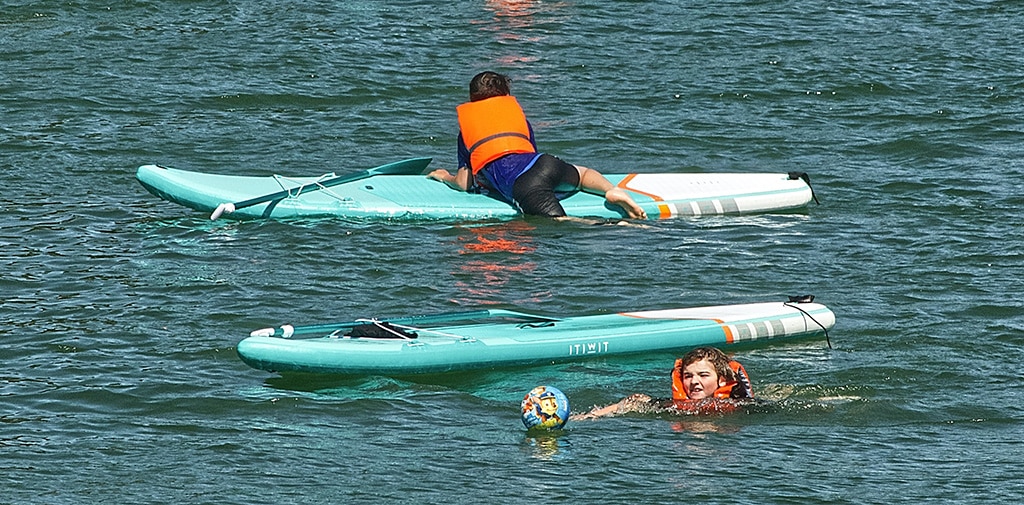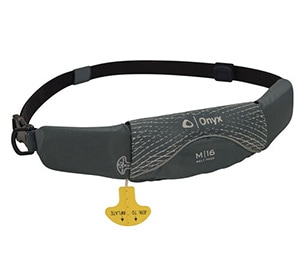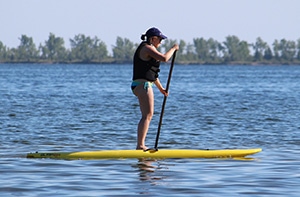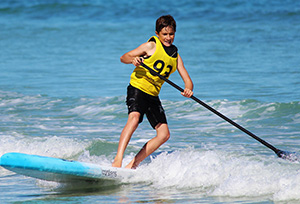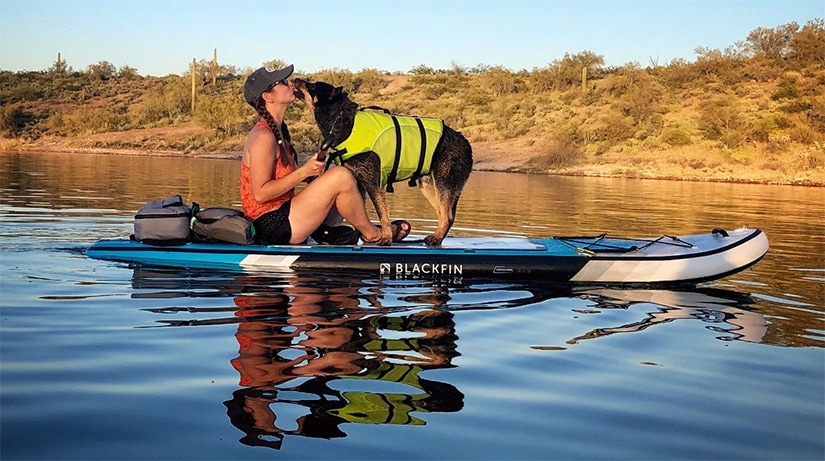If you’re heading out on your paddleboard, it’s important to follow your locality’s rules and while on the water. One aspect of your safety that should never be ignored is your life jacket. Across the nation, paddlers are required to have with them a personal floatation device of PFD at all times.
Let’s go over the details of these life jacket rules and how they apply to different paddlers. Depending on your age and where you paddle, these rules can shift. Understanding and following these life jacket requirements ensure that you are that much safer while on your paddleboard.
Read on to find out what you need to know about paddle boarding and life jacket requirements.
RELATED: What is the best pfd for paddle boarding in 2024?
Key Takeaways
- Paddlers aged 13 or older must have a USCG-approved life jacket with them, while paddlers 12 or younger must wear one.
- There are five types of life jackets, each with different buoyancy, comfort, and safety features.
- Life jackets should fit properly according to chest size for adults and weight for children. They should also be in good condition and free of damage.
- Paddleboards are considered vessels and must follow the Navigation Rules. Paddlers must also report any accidents or injuries to the local authority.
- Paddlers should bring a whistle, a flashlight, and a SUP board leash too for their safety and visibility on the water.
Paddleboard Life Jacket Requirements
The United States Coast Guard or (USCG) details certain rules and guidelines when paddleboarding in open waters, rivers, and lakes. Unsurprisingly, much of these guidelines are related to the use of an appropriately fitting life jacket, or personal floatation device (PFDs). The USCG details the following guidelines when it comes to paddleboarding life jacket requirements.
- Paddlers aged 13 years or older must have a USCG approved Type I, II, III, or appropriately sized Type V (more on these in a moment) life vest. Paddlers 13 and up are not required to wear a life vest, but it is strongly recommended.
- For paddlers age 12 years old or younger, they are legally required to wear an appropriately sized USCG approved life vest.
- The life jacket used by a paddler must be in “serviceable condition.” This means that the life jacket must be free of rips, tears, and other signs of deterioration. Such flaws could impact the performance of the life jacket.
- Type V (specialty use devices) may be used by paddlers as long as the device is USCG approved and is applicable for the activity at hand.
- An inflatable life jacket and pouch styled jacket is allowed to be used by paddlers so long as it is worn as they paddle. Inflatable PFDs require different maintenance checks than traditional life jackets. It’s important to check an inflatable PFD to ensure that it is ready to inflate when you need to use it.
With all life jackets, especially inflatables and PFDs, it’s important to read and understand the manufacturer’s safety label in order to make sure you’re using the life jacket properly.
What Is a USCG Approved Life Jacket?
We’ve mentioned the term “USCG approved life jacket,” but what exactly does that mean? Essentially, this term is used to describe a standard by which the USCG has set for life jackets in order to ensure they maintain a high degree of safety.
A life vest or inflatable life jacket that meets USCG approval is one that has met all the federal regulations and safety standards set by the USCG.
What Are the 5 Life Jacket Classifications
As you shop around for a life jacket or PFD, you will come across several different types. There are five types of classifications that are universally recognized. Let’s go over what they are and why a paddler might prefer one over the other.
Type I — Offshore Life Jackets
This type of life jacket is the most buoyant class of PFDs. Their buoyancy allows them to be ideal for use in any water conditions and can keep you afloat in rough, choppy, open waters. By nature of their design, these life vests are typically bulky, snug, and will fit you very much the way a commercial ship life vest would.
Type one jackets will have some sort of neck support and will usually turn your face upright in the event you are unconscious when you fall into the water. They have a minimum buoyancy rating of 22 pounds for adults, 11 pounds for a child, and 7 pounds for an infant.
Type II — Near-Shore Buoyancy Vest
Nearshore buoyancy vests or type two vests look and feel a lot like type one vests, but they have a little more comfort and a bit less stiffness to them.
These types of vests are designed for inland water sources like lakes and calm rivers. Much like a type one, these vests will often come with neck support as well, allowing unconscious individuals to flip face up. They have a minimum buoyancy of 15.5 pounds for adults, 11 pounds for children, and 7 pounds for infants.
Type III — The Floatation Aid
The floatation aid or type III life vest is what typically comes to mind when people think about a personal floatation device. A type III PFD will fit a wearer very comfortably. These PFDs are almost always designed like a buoyant vest that zips or buckles up at the front.
These aids can often feel “fitted” as they conform to your body the way your clothing would. Because of this, they are some of the most common types of PFDs to wear while out on the water. They don’t restrict movement, and they feel very comfortable.
Despite their comfort, they do lack some safety features. For example, floatation aids do not support the neck and will not float a wearer face up if they were to go unconscious in the water.
They are designed for use on clam water, where quick rescues are likely. These are the ideal types of PFDs to wear while engaging in general boating activities, paddleboarding, and typical playing and swimming in the water. They have a minimum buoyancy of 15.5 pounds for adults, 11 pounds for children, and 7 pounds for infants.
Type IV — Throwable Device
As the name suggests, a throwable device is a floatation device that is thrown out to individuals while they are in the water. Throwable devices can take on narrow designs, square designs, and circular floats with a donut hole in the middle.
These types of flotation devices are best used in calm waters where rescues are easily conducted. Throwable devices are not designed to be worn the way life vests are. Instead, they are to be used as a supplement to a life vest. The minimum buoyancy varies but can range anywhere from 15 pounds to 18 pounds.
Type V — The Specialty Use Device
Specialty use floatation devices or type five life vests are designed for use in a specific activity. For example, common type five vests are typically designed for activities including white water rafting, work-type jackets, and for use with hybrid inflatables.
Because these vests are designed for a specific specialty, the instructions for using these vests on the water may vary from model to model. It’s important to read the manufacturer’s instructions carefully.
Depending on the type of vest it is, the minimum buoyancy may vary. However, it will typically be anywhere from 15 pounds to 22 pounds.
ALSO READ: How often should the inflator on a type V life jacket be checked?
Standard Life Jacket Sizes for Adults
The size of your PFD and the way it fits depends on two factors; your chest size, and the fit type you’re looking for. Standard, commercial life jackets can offer a really loose, yet comfortable fit. Other types of PFDs from well recognized brands can offer a more snug fit.
To find the right life jacket size for yourself, you’ll need to start by finding your chest size. You can find your chest size by measuring the circumference of your chest at the point where it is the broadest. Once you have that number, use it to compare with the sizing provided by your lifejacket manufacturer. (The sizing can usually be found on the inside or your life jacket.)
Typically, you will find the following size recommendations for standard adult size life jackets:
- Extra Small: fits 28-32” chest
- Small: fits 23-36” chest
- Medium: fits 36-40” chest
- Large: fits 40-44” chest
- X-Large: fits 44-48” chest
- XX-Large: fits 48-52” chest
- XXX-Large fits 52-56” chest
Standard Life Jacket Sizing for Kids
Unlike adult sized life jackets, life jacket sizing for kids depends on a child’s weight, not their chest size. The following weight recommendations will help guide you when picking out the best life jacket for your child.
- Infant PFD: 8-30lbs
- Child PFD: 30-50lbs
- Youth PFD 50-90lbs
Life jacket manufacturers might have their own sizing guidelines for their child sized PFDs as well. It’s important to understand the size recommendations, to ensure it will fit your child.
Never purchase a life jacket for your child with the intention of them “growing into it.” It’s important that a life jacket properly fits your child in order for it to be effective. A child’s life jacket should do the following:
- Fit them snugly, but not restrictively.
- Allow them to keep their head above water.
- Have a crotch strap to keep the life jacket from riding up.
- For a younger child, the life jacket should have a padded neck support to help keep their head above water.
U.S. Coast Guard Regulations for Stand Up Paddling
Much like kayaks and other smaller watercraft, stand up paddle boards are considered “vessels.” As such, all paddleboarders are required to follow the Navigation Rules as detailed by the USCG. Other guidelines include the following:
- Vessel operators (paddlers) are responsible for reporting a boating accident and/or any injuries sustained to the local reporting authority.
- In most states, you do not have to register your paddleboard or display registration numbers. However, it’s important to check with your local jurisdiction for registration rules in your locality. Most states also won’t require hull identification numbers for your stand up paddle board.
Paddling Gear Required by The Coast Guard
There are also some USCG regulations when it comes to the safety gear you bring. The National Coast Guard requires that all operators of paddle boards bring with them a whistle and a flashlight.
A whistle or any other sound-producing device can come in handy if you have lost your board or have drifted a far distance.
A flashlight or other illumination device is required if you’re out on the water after sunset. Along with your safety, a flashlight will alert other boaters that you are in the water.
Additional Safety Gear for Paddle Boarding
While not required, there are additional items you may want to bring along with you to maximize your safety on the water. The following accessories are not required by the National Coast Guard but are highly recommended.
SUP Board Leash
A SUP board leash is such a critical piece of safety equipment every paddler should have with them.
SUP board leashes keep you connected to your board so that if you ever fall off, your board will stay nearby. A board leash is connected to the base of your SUP with the other end connecting to your ankle via a velcro strap.
Quick Release Belt (For River SUP)
If you’re chasing rapids on your stand up paddleboard, then a quick release belt is a great safety accessory to invest in.
This belt works much the way a SUP board leash does with the main difference being it straps around your waist, not ankle. This belt was designed specifically for rough rapids because a paddler stays strapped to their board and can easily unhook when they need to.
Waterproof Flashlight
Having a waterproof flashlight with you can come in handy, especially if you are going out in the evening hours. A flashlight can help you see better, but it can also help other paddle craft and larger boats see you as well. Of course, in the event of an emergency, a waterproof flashlight can come in handy as well.
Sun Protection
Paddleboarding can make you extremely vulnerable to the sun’s harmful rays. Because of this, it’s important to consider having proper sun protection when you go out.
Invest in a broad spectrum, waterproof sunscreen and apply it to the parts of your body that will be exposed to the sun while you’re out. If you want to avoid slathering sunscreen altogether, you can opt for a full coverage swimming, surfing, or bathing suit instead.
Having a hat or visor that protects your head and face will also help keep you protected against the sun’s rays.
Conclusion
Paddleboarding is such a fun and relaxing activity. However, if you don’t have the right safety gear, it can turn dangerous quickly. Understanding what the guidelines are when it comes to wearing a life jacket while paddleboarding is critical.
Shop for a personal floatation device that is an appropriate size, and consider investing in additional safety gear to increase your safety while out on the water.

